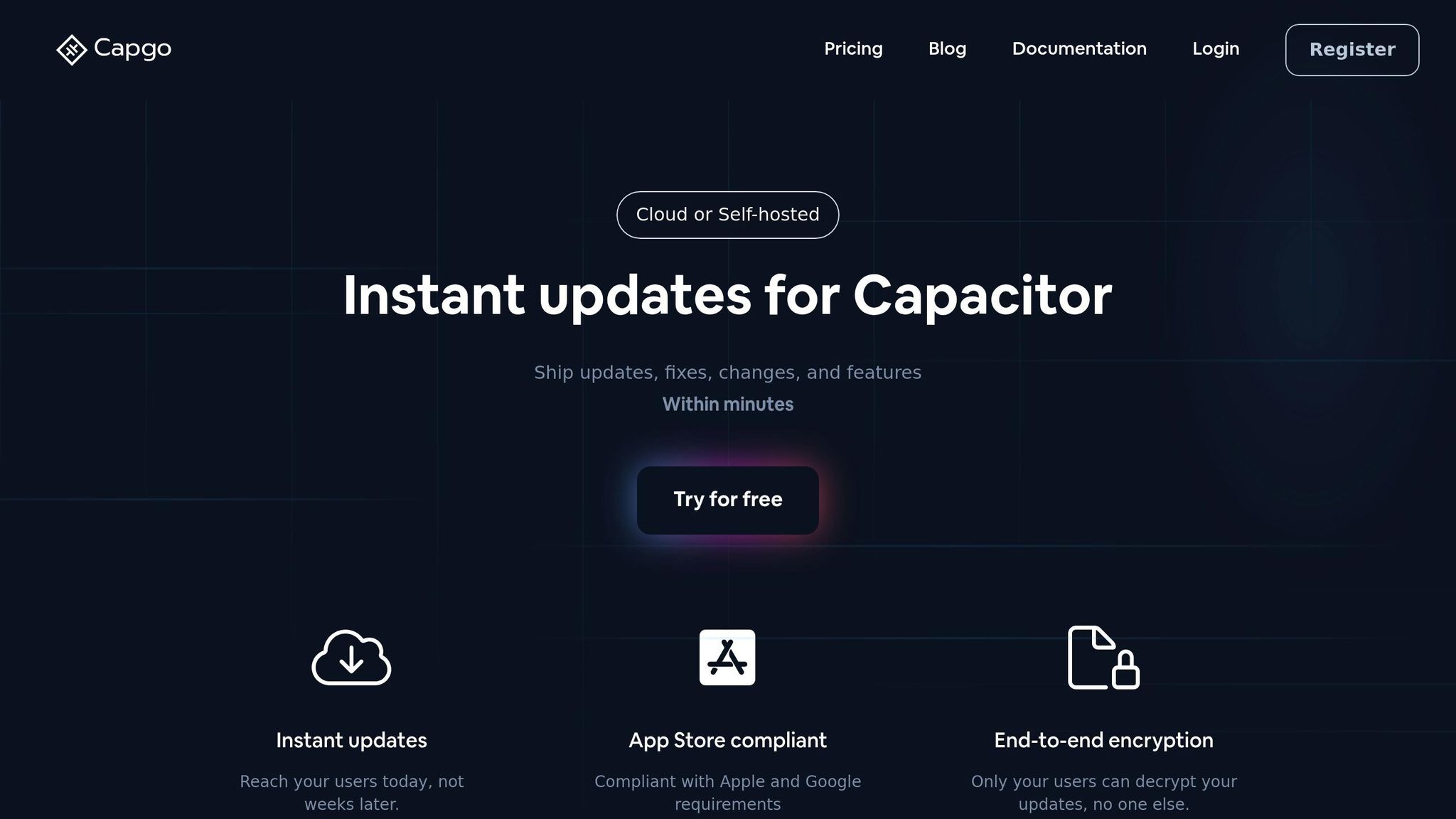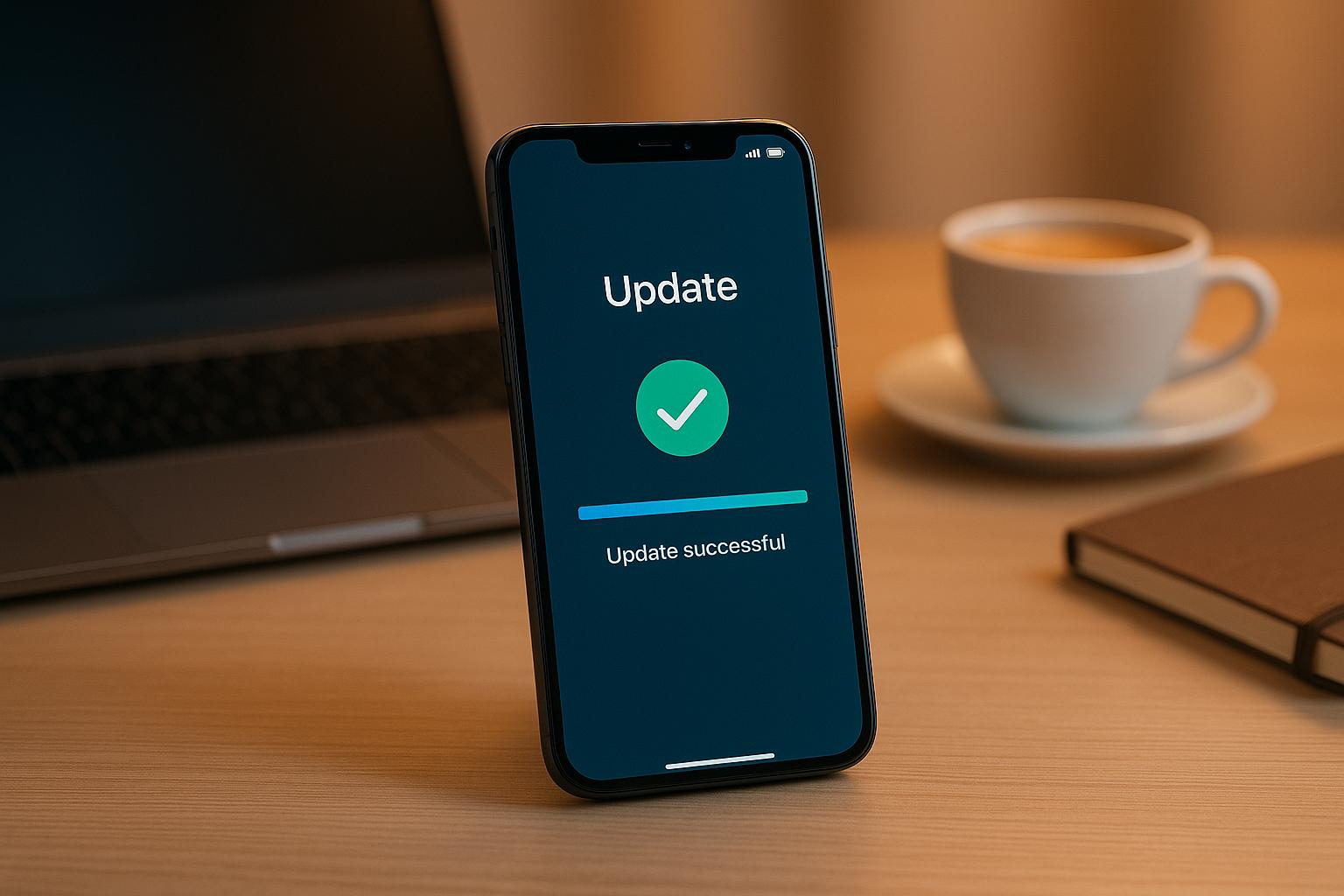Capgo lets you update your Capacitor apps instantly without waiting for app store approvals. It delivers fast, secure, and compliant over-the-air (OTA) updates. Here’s what you need to know:
- Fast Updates: 95% of users get updates within 24 hours, with 5MB bundles delivered in 114ms.
- Easy Setup: Install the plugin with
npm install @capgo/capacitor-updater, sync your project, and configure updates in minutes. - Secure & Compliant: End-to-end encryption and adherence to Apple and Google guidelines.
- Flexible Rollouts: Assign updates to specific user groups (e.g., beta, production) for controlled releases.
- Error Handling: Real-time tracking, rollback options, and partial updates ensure stability.
Capgo is designed for seamless, lightweight deployment, so you can focus on improving your app while updates happen in the background.
Getting Started with Capgo

Getting Capgo up and running in your Capacitor project is straightforward. It involves a quick installation process and some basic configuration.
System Requirements
Before diving in, make sure your development environment meets these minimum requirements:
| Component | Minimum Requirement |
|---|---|
| Node.js | Latest LTS version |
| Capacitor | Version 3.0 or higher |
| Platform Tools | Xcode (for iOS) or Android Studio |
You’ll also need to have the necessary tools installed for Capacitor development, such as Xcode for iOS or Android Studio for Android.
Plugin Installation Steps
Here’s how you can install and set up Capgo:
-
Step 1: Install the Capgo Plugin
Run the following command to install the Capgo updater plugin:
Terminal window npm install @capgo/capacitor-updater -
Step 2: Sync Your Project
After installing the plugin, sync it with your Capacitor project:
Terminal window npx cap sync -
Step 3: Set Up Live Updates
To enable live updates, install the Capgo CLI and initialize it:
Terminal window npm install @capgo/clinpx @capgo/cli init
Once the setup is complete, you can move on to configuring your project for hassle-free updates.
Basic Configuration
To configure Capgo in your Capacitor project, update the capacitor.config.ts file with the following settings:
{ plugins: { CapacitorUpdater: { autoUpdate: true, updateUrl: 'https://api.capgo.app/updates' } }}You can fine-tune these settings based on your project’s needs. Here’s a quick overview of the available options:
| Setting | Purpose | Recommended Value |
|---|---|---|
| autoUpdate | Enables automatic updates | true |
| updateUrl | The endpoint for updates | https://api.capgo.app/updates |
With these configurations in place, your project is ready to handle live updates efficiently.
Managing OTA Updates
Setting Up Update Automation
Using Capgo to automate updates simplifies your deployment process. Start by authenticating your CLI access with the following command:
npx @capgo/cli@latest init API_KEYNext, create an update bundle from your current code by running:
npx @capgo/cli app updateOnce configured, Capgo automatically checks for updates when the app starts, installs them in the background, and applies changes during the next restart.
| Update Type | Timing | User Impact |
|---|---|---|
| Background Check | App startup | No interruption |
| Manual Trigger | On-demand | Minimal disruption |
| Push Notification | Event-based | User-controlled |
After automating updates, you can use Capgo’s channel system to customize the rollout process for different user groups.
Update Distribution Control
Capgo allows you to assign specific update versions to different channels, providing flexibility in managing deployments. Here’s an example configuration:
{ "channels": { "beta": "v2.0.0-beta", "production": "v1.9.5", "enterprise": "v1.9.5-ent" }}This setup ensures organized deployments, as described below:
| Channel | Purpose | Update Frequency |
|---|---|---|
| Beta | Early feature testing | Weekly |
| Production | Stable releases | Bi-weekly |
| Enterprise | Business clients | Monthly |
| Power Users | Performance updates | As needed |
By assigning updates to specific channels, you can test new features with smaller groups before rolling them out to all users.
Update Error Handling
Once updates are set up and distributed, Capgo’s error management features help maintain app stability. These include:
- Real-time tracking: Monitor update progress across devices.
- Robust security: Ensure updates are safe and tamper-proof.
- One-click rollback: Quickly revert to a stable version if needed.
- Partial updates: Deliver only modified files to optimize performance.
For managing errors effectively, consider leveraging these tools:
| Feature | Function | Implementation |
|---|---|---|
| Automatic Retries | Resolves network issues | Built-in Capgo functionality |
| Version Control | Tracks update sources | Git integration |
| Error Logging | Monitors update problems | Dashboard analytics |
| Rollback System | Restores stable versions | Single command reversion |
Using the channel system for gradual rollouts reduces risks and ensures your app remains stable, even when updates encounter issues.
Security and App Store Rules
Update Encryption System
Capgo secures its update packages using end-to-end encryption, prioritizing critical security features to safeguard data. Here’s how it works:
| Security Feature | Implementation | Benefit |
|---|---|---|
| End-to-End Encryption | Secure methods | Blocks unauthorized access |
| Key Management | Hardware storage | Keeps encryption keys protected |
| Access Controls | Role-based permissions | Restricts update distribution access |
These measures, combined with strict adherence to platform security guidelines, have contributed to an impressive 82% global success rate across more than 750 production apps [2].
Platform Guidelines
Capgo ensures full compliance with iOS and Android app store requirements, aligning with their specific rules for secure and transparent app operations.
For iOS applications, developers must:
- Offer clear in-app account deletion options.
- Maintain transparent data collection practices.
- Use Apple’s REST API for token revocation when implementing “Sign in with Apple.”
On the Android side, Google Play requires:
- Clear notifications for pending updates.
- End-to-end encryption for all update packages.
- Detailed version control for better transparency.
By meeting these guidelines, Capgo has facilitated 23.5 million successful updates while maintaining compliance [2]. Additionally, the platform actively monitors update performance to ensure continuous improvement.
Update Tracking System
To complement its secure update delivery, Capgo’s tracking system provides real-time monitoring to optimize performance and detect potential issues. Here’s a closer look:
| Monitoring Component | Purpose | Success Metric |
|---|---|---|
| Real-time Analytics | Tracks update success rates | 95% adoption within 24 hours |
| Performance Tracking | Optimizes download speeds | Improves response times |
| Error Detection | Identifies issues quickly | Monitors download speeds |
| Version Management | Controls update distribution | Tracks overall success rates |
This robust tracking system ensures secure, efficient updates, reinforcing Capgo’s dedication to reliable and seamless update distribution.
Update Performance Tips
Keep your updates running smoothly and without interruptions by focusing on performance optimization.
Reducing Update Size
Capgo uses delta updates, meaning only the changes between versions are delivered. To further minimize update sizes, consider these strategies:
| Optimization Technique | Impact | Implementation |
|---|---|---|
| Code Minification | Shrinks code size | Compress JavaScript, CSS, and HTML files |
| WebP Image Format | Reduces image file sizes | Convert static images to WebP format |
| Vector Graphics | Small size with scalability | Use for icons and logos instead of raster images |
| Resource Cleanup | Eliminates unnecessary assets | Remove unused files and resources |
For best results, focus on these steps:
- Convert images to WebP for smaller file sizes.
- Replace raster images with vector graphics whenever possible.
- Enable tools that shrink and minify your code.
- Regularly clean up unused resources and debug symbols.
Background Update Loading
Ensure updates are seamless by loading them in the background. Here are some ways to improve efficiency:
- Use Capacitor’s Filesystem API for caching and local storage.
- Handle files more efficiently by using blobs instead of base64 strings.
- Incorporate lazy loading to reduce initial app load times.
This approach ensures that users experience uninterrupted functionality while updates are applied in the background.
Update Size Management
Managing the overall size of your updates is just as important as how they load. Keeping the package size in check ensures the app remains responsive and efficient. Here’s how you can do it:
- Regularly audit and remove unused resources.
- Apply app thinning techniques for iOS to reduce the bundle size.
- Optimize local databases to handle data more efficiently.
- Compress image assets to save space.
- Reuse resources dynamically through runtime customization.
Conclusion
Capgo stands out as a reliable solution for deploying Capacitor apps, supported by its impressive track record of delivering over 1.7 trillion updates across more than 2,000 production apps [1]. This level of performance highlights its ability to handle large-scale, real-world deployments with ease.
The platform simplifies the deployment process with features like:
- End-to-end encryption for secure update delivery
- Differential updates to minimize bandwidth usage
- Seamless CI/CD integration with popular platforms
- App store compliance for iOS and Android
- One-click rollback for quick version control
Capgo combines efficiency, security, and compliance, making it an excellent choice for teams seeking a lightweight and effective deployment solution. Its feature-rich platform addresses the challenges of modern app deployment while staying within platform requirements.
Want to simplify your app’s deployment process? Start using Capgo today to streamline updates and boost your app’s performance.
FAQs
::: faq
How does Capgo stay compliant with Apple and Google guidelines while offering over-the-air updates?
How Capgo Stays Compliant with App Store Guidelines
Capgo ensures it meets all Apple and Google app store guidelines by strictly following their update policies. For Apple, updates are limited to non-executable content, while Google offers more flexibility but demands stringent security measures. Capgo addresses these requirements by implementing end-to-end encryption, obtaining users’ consent for updates, and aligning with each platform’s specific rules.
To keep everything on track, Capgo regularly audits its update systems and monitors policy changes. These efforts guarantee that over-the-air updates remain secure, seamless, and fully compliant - offering developers and users confidence in the process. :::
::: faq
What are the benefits of using Capgo’s channel system for managing app updates, and how does it improve app reliability?
Capgo’s channel system enables targeted update distribution, giving developers the flexibility to release updates to specific groups of users. This approach is perfect for staged rollouts, beta testing, or running controlled experiments. By starting with smaller groups, developers can identify and fix issues early, which helps enhance the app’s reliability.
Another advantage of the system is its support for quick rollbacks, allowing users to revert to a stable version if any problems occur. Combined with real-time updates, Capgo ensures that fixes and new features reach users instantly - bypassing the delays of app store approval processes - keeping the app running smoothly and users happy. :::
::: faq
How can developers improve update performance and reduce update size when using Capgo with their Capacitor apps?
To make updates faster and keep their size manageable with Capgo, developers can focus on a few practical techniques:
- Leverage differential updates: Instead of re-sending the entire app, only send the parts that have changed. This approach drastically cuts down the update size.
- Use effective compression: Implement compression methods like ZSTD to shrink update files even further.
- Structure your code thoughtfully: Divide your code into smaller, modular pieces to speed up and streamline the update process.
On top of these practices, tracking your app’s performance with tools like Firebase can highlight areas for improvement. This helps ensure updates are not just smaller but also enhance the user experience. Together, these steps allow developers to provide smooth, real-time updates while keeping the app reliable and efficient. :::




